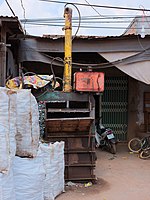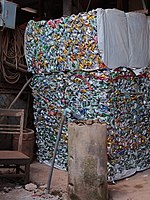Templates for Making Toy Planes and Boats From Beer and Soda Drink Cans

An aluminium recycling symbol.

Aluminium recycling is the process by which chip aluminium can be reused in products subsequently its initial product. The process involves just re-melting the metal, which is far less expensive and energy-intensive than creating new aluminium through the electrolysis of aluminium oxide (AliiO3 ), which must start be mined from bauxite ore and then refined into aluminium oxide using the Bayer procedure and and so refined again into aluminium metal using the Hall–Héroult process.
Recycling scrap aluminium requires simply 5% of the energy used to make new aluminium from the raw ore.[ane] For this reason, approximately 36% of all aluminium produced in the United States comes from sometime recycled chip.[2] Used drinkable containers are the largest component of processed aluminum scrap, and most of it is manufactured dorsum into aluminium cans.[3]
History [edit]
A common practice since the early 1900s and extensively capitalized during Earth State of war Two, aluminium recycling is non new. Information technology was, however, a low-profile activity until the late 1960s, when the exploding popularity of aluminium drink cans finally placed recycling into the public consciousness.[4]

Sources for recycled aluminium include shipping, automobiles, bicycles, boats, computers, cookware, gutters, siding, wire, and many other products that need a strong lightweight material, or a material with high thermal conductivity. As recycling does non transmute the chemical element, aluminium tin can exist recycled indefinitely and still be used to produce whatsoever product for which new aluminium could take been used.[v]


Hydraulic press and baled cans prepared for ship
Advantages [edit]
Aluminium is an infinitely recyclable material, and it takes up to 95 pct less energy to recycle it than to produce primary aluminum, which also limits emissions, including greenhouse gases. Today, about 75 percent of all aluminum produced in history, nearly a billion tons, is notwithstanding in utilize.[6]
The recycling of aluminium generally produces pregnant cost savings over the production of new aluminium, even when the cost of collection, separation and recycling are taken into business relationship.[7] Over the long term, even larger national savings are made when the reduction in the uppercase costs associated with landfills, mines, and international shipping of raw aluminium are considered.
Free energy savings [edit]
Recycling aluminium uses most 5% of the energy required to create aluminium from bauxite;[viii] [ improve source needed ] the amount of energy required to convert aluminium oxide into aluminium can be vividly seen when the procedure is reversed during the combustion of thermite or ammonium perchlorate composite propellant.
Aluminium dice extrusion is a specific way of getting reusable fabric from aluminium scraps simply does not crave a large energy output of a melting process. In 2003, half of the products manufactured with aluminium were sourced from recycled aluminium cloth.[9]
Environmental savings [edit]
The benefit with respect to emissions of carbon dioxide depends on the type of energy used. Electrolysis tin be done using electricity from non-fossil-fuel sources, such as nuclear, geothermal, hydroelectric, or solar. Aluminium product is attracted to sources of inexpensive electricity. Canada, Brazil, Kingdom of norway, and Venezuela have 61 to 99% hydroelectric power and are major aluminium producers. The utilise of recycled aluminium also decreases the demand for mining bauxite.
The vast amount of aluminium used ways that even modest percentage losses are large expenses, so the flow of material is well monitored and accounted for financial reasons. Efficient production and recycling benefits the surround as well.[10]
Process for beverage cans [edit]
Aluminium beverage cans are ordinarily recycled by the post-obit method:[eleven]
- Cans are first divided from municipal waste matter, usually through an boil electric current separator, and cut into small, equally sized pieces to lessen the volume and make it easier for the machines that separate them.
- Pieces are cleaned chemically/mechanically and blocked to minimize oxidation losses when melted. (The surface of aluminium readily oxidizes back into aluminium oxide when exposed to oxygen.[12])
- Blocks are loaded into the furnace and heated to 750 °C ± 100 °C to produce molten aluminium.
- Dross is removed, and the dissolved hydrogen is degassed. (Molten aluminium readily disassociates hydrogen from water vapor and hydrocarbon contaminants.) This is typically done with chlorine and nitrogen gas. Hexachloroethane tablets are normally used as the source for chlorine. Ammonium perchlorate can also exist used, equally it decomposes mainly into chlorine, nitrogen, and oxygen when heated.[thirteen]
- Samples are taken for spectroscopic analysis. Depending on the final production desired, high-purity aluminium, copper, zinc, manganese, silicon, and/or magnesium is added to change the molten limerick to the proper alloy specification. The peak-five aluminium alloys produced are 6061, 7075, 1100, 6063, and 2024.
- The furnace is tapped, the molten aluminium poured out, and the procedure is repeated once again for the next batch. Depending on the end production, it may be bandage into ingots, billets, or rods, formed into big slabs for rolling, atomized into pulverization, sent to an extruder, or transported in its molten state to manufacturing facilities for further processing.[14]
Ingot production using reverberatory furnaces [edit]
The scrap aluminium is separated into a range of categories such equally irony aluminium (engine blocks etc.), make clean aluminium (alloy wheels). Scraps are classified according to ISRI (Institute of Scrap Recycling Industries).
Depending on the specification of the required ingot casting, it will depend on the type of flake used in the get-go melt. More often than not, the scrap is charged to a reverberatory furnace (other methods appear to exist either less economical and/or dangerous) and melted downwards to course a "bathroom". The molten metal is tested using spectroscopy on a sample taken from the cook to determine what refinements are needed to produce the final casts.
Later on the refinements have been added, the melt may be tested several times to exist able to fine-melody the batch to the specific standard.
In one case the correct "recipe" of metal is bachelor, the furnace is tapped and poured into ingot moulds, commonly via a casting machine. The cook is then left to cool, stacked and sold on as cast silicon–aluminium ingot to various industries for re-use. Mainly, cast alloys like ADC12, LM2, AlSi132, LM24 etc. are produced. These secondary alloys ingots are used in dice cast companies.
Tilting rotary furnaces are used for recycling of aluminium scrap, which requite higher recovery compared to reverberatory furnaces (Skelner Furnace).
Recycling rates [edit]
Brazil recycles 98.2% of its aluminium tin product, equivalent to xiv.vii billion beverage cans per year,[15] ranking showtime in the world, more than Japan's 82.5% recovery rate. Brazil has topped the aluminium can recycling charts eight years in a row.[sixteen]
Secondary aluminium recycling [edit]
White dross, a residue from principal aluminium production and secondary recycling operations, usually classified as waste,[17] still contains useful quantities of aluminium which can exist extracted industrially.[18] The procedure produces aluminium billets, together with a highly complex waste matter. This waste is difficult to manage. It reacts with h2o, releasing a mixture of gases (including, among others, hydrogen, acetylene, and ammonia) which spontaneously ignites on contact with air;[19] contact with damp air results in the release of copious quantities of ammonia gas. Despite these difficulties, nonetheless, the waste has found employ as a filler in cobblestone and concrete.[20]
See as well [edit]
- Environmental problems with mining
- Ferrous metal recycling
References [edit]
- ^ "The price of virtue". The Economist. 7 June 2007.
- ^ minerals.usgs.gov
- ^ EPA. "Common Wastes & Fabric". Retrieved 27 April 2012.
- ^ Schlesinger, Mark (2006). Aluminum Recycling. CRC Press. p. 248. ISBN978-0-8493-9662-5.
- ^ "WasteOnline: Metals aluminium and steel recycling". Archived from the original on 2007-10-16. Retrieved 2006-06-06 .
- ^ AG, interstruct. "Aluminium Recycling – Développement durable". recycling.world-aluminium.org . Retrieved 2018-10-26 .
- ^ International Aluminum Institute
- ^ Aluminum: The Element of Sustainability A N American Aluminum Industry Sustainability Written report (PDF) (Report). The Aluminum Association. September 2011.
- ^ "Manufacturing with Die Casting: An Eco-Friendly Selection". NADCA Design. 2017-01-21. Retrieved 2017-03-08 .
- ^ "Aluminium system: Environmental issues". Archived from the original on 2010-ten-06. Retrieved 2010-xi-28 .
- ^ aluminum.org: How Is An Aluminum Can Recycled?
- ^ world wide web.metalwebnews.com: Melting Practice
- ^ "Aluminum and Aluminum Alloys Casting Problems". central-to-metals.com.
- ^ Alcoa Primary Aluminum - North America: Products
- ^ "In 2009, Brazil was, once over again, the leading country worldwide in the drove of aluminium drink cans, with a recycling rate of 98.ii%". Alu - Aluminium for future generations. 2010. Retrieved 2013-03-26 .
- ^ "Brazil'due south unemployed catadores keep recycling rates high while earning much-needed cash. - Free Online Library". Thefreelibrary.com. 2010-03-22. Retrieved 2012-eleven-15 .
- ^ Residues from aluminium dross recycling in cement
- ^ Hwang, J.Y., Huang, X., Xu, Z. (2006), Recovery of Metals from Aluminum Dross and Salt cake, Journal of Minerals & Materials Characterization & Engineering. Vol. 5, No. 1, pp 47-62
- ^ Why are dross & saltcake a concern?
- ^ Dunster, A.M., Moulinier, F., Abbott, B., Conroy, A., Adams, K., Widyatmoko, D.(2005). Added value of using new industrial waste streams as secondary aggregates in both concrete and asphalt. DTI/WRAP Aggregates Inquiry Programme STBF 13/15C. The Waste and Resources Action Programme
External links [edit]
- Secondary Aluminum Smelters of the Globe - A list of companies who produce secondary aluminium (i.e., recycled or remelted from scrap metal)
Source: https://en.wikipedia.org/wiki/Aluminium_recycling
0 Response to "Templates for Making Toy Planes and Boats From Beer and Soda Drink Cans"
Postar um comentário